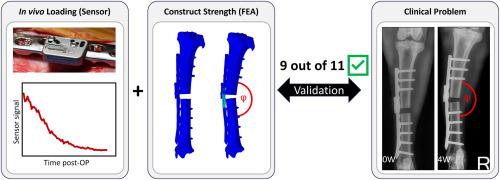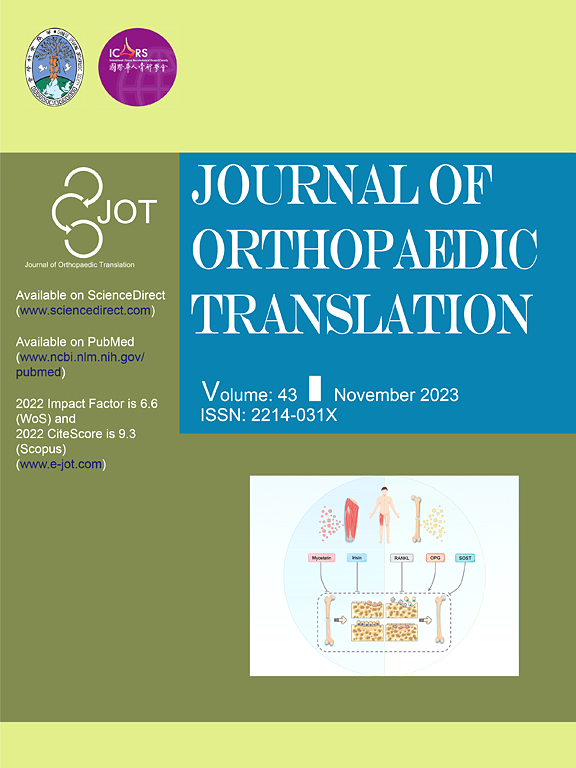Preclinical validation of finite element models for predicting in vivo residual plate bending using continuous implant sensor data
IF 5.9
1区 医学
Q1 ORTHOPEDICS
引用次数: 0
Abstract
Background/objective
Plate failure, including bending, is a critical issue in orthopedic fracture fixation, with clinical failure rates of 3.5%–19%, burdening patients and healthcare systems. Preclinical ovine models have observed similar plate bending due to overloading. Finite element (FE) models could be capable of predicting failures but lack in vivo loading data for validation. The AO Fracture Monitor is an implantable sensor that can continuously track implant deformation, offering a proxy for implant loading and the potential to bridge this gap. This study aimed to preclinically validate an FE simulation methodology for predicting overloading bending of locking plates in an ovine tibia osteotomy model using AO Fracture Monitor data, emphasizing its potential for clinical translation.
Methods
Tibiae of eleven sheep with osteotomy gaps (0.6 – 30 mm) were instrumented with stainless steel or titanium locking plates equipped with AO Fracture Monitors in a prior study. Residual plate bending angles were measured using co-registered CT scans at 0 and 4 weeks post-operation, with bending defined as ≥ 1°. Animal-specific FE models, incorporating virtual AO Fracture Monitors and non-linear implant material properties, were developed to determine sensor signals at the construct's yield point. In vivo sensor signals were compared to the virtual plasticity threshold to predict CT-based residual bending outcomes.
Results
Within 4 weeks, plate bending angles ranged from 0.4° to 10.4°, with overloading bending observed in 6 animals. The FE methodology correctly predicted bending/no-bending outcomes in 9 of 11 animals, achieving 100% sensitivity and 60% specificity.
Conclusions
This sensor-validated FE methodology robustly predicted in vivo plate bending, offering a promising tool for reducing implant failure. These findings highlight the methodology's ability to detect clinically relevant bending outcomes. By integrating real-time loading data, it supports the development of personalized rehabilitation strategies, enhancing clinical outcomes in fracture fixation.
The Translational Potential of this Article
This validated FE methodology, leveraging AO Fracture Monitor data, can be adapted for human use to tailor rehabilitation protocols immediately post-surgery and provide real-time feedback to patients and clinicians if loading exceeds safe thresholds. This approach could minimize implant failure, reduce revision surgeries, and enhance patient recovery.

使用连续植入物传感器数据预测体内残余板弯曲的有限元模型的临床前验证
背景/目的钢板失效,包括弯曲,是骨科骨折固定中的一个关键问题,临床失败率为3.5%-19%,给患者和医疗系统带来了负担。临床前的羊模型也观察到类似的板因超载而弯曲。有限元(FE)模型可以预测失效,但缺乏体内加载数据进行验证。AO骨折监测器是一种可植入的传感器,可以连续跟踪植入物的变形,提供植入物载荷的代理,并有可能弥补这一差距。本研究旨在临床前验证利用AO骨折监测数据预测羊胫骨截骨模型中锁定钢板超载弯曲的有限元模拟方法,强调其临床转化的潜力。方法对11只羊的截骨间隙(0.6 ~ 30mm)采用不锈钢或钛锁定钢板固定,并配以AO骨折监护仪。术后第0周和第4周采用共登记CT扫描测量残余板弯曲角度,弯曲定义为≥1°。结合虚拟AO骨折监视器和非线性植入物材料特性的动物特异性FE模型被开发出来,以确定构建体屈服点的传感器信号。将体内传感器信号与虚拟塑性阈值进行比较,以预测基于ct的残余弯曲结果。结果在4周内,钢板弯曲角度在0.4°到10.4°之间,6只动物观察到超载弯曲。FE方法正确预测了11只动物中9只的弯曲/无弯曲结果,达到100%的灵敏度和60%的特异性。结论:该传感器验证的有限元方法可有效预测体内钢板弯曲,为减少植入失败提供了一种有前途的工具。这些发现突出了该方法检测临床相关弯曲结果的能力。通过整合实时载荷数据,它支持个性化康复策略的发展,提高骨折固定的临床效果。利用AO骨折监测数据,这种经过验证的FE方法可用于人类手术后立即定制康复方案,并在负荷超过安全阈值时向患者和临床医生提供实时反馈。这种方法可以减少种植失败,减少翻修手术,提高患者的康复。
本文章由计算机程序翻译,如有差异,请以英文原文为准。
求助全文
约1分钟内获得全文
求助全文
来源期刊

Journal of Orthopaedic Translation
Medicine-Orthopedics and Sports Medicine
CiteScore
11.80
自引率
13.60%
发文量
91
审稿时长
29 days
期刊介绍:
The Journal of Orthopaedic Translation (JOT) is the official peer-reviewed, open access journal of the Chinese Speaking Orthopaedic Society (CSOS) and the International Chinese Musculoskeletal Research Society (ICMRS). It is published quarterly, in January, April, July and October, by Elsevier.
 求助内容:
求助内容: 应助结果提醒方式:
应助结果提醒方式:


